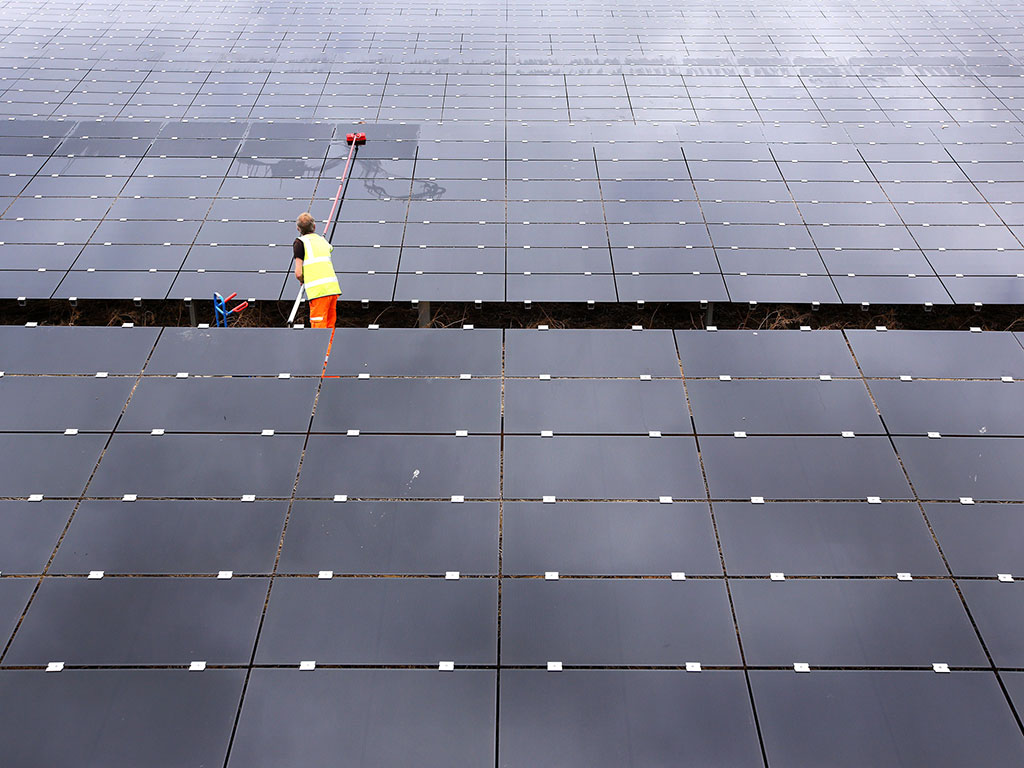Why EU tariffs on Chinese solar panels need to end
Import tariffs on Chinese solar PV hurt the domestic industry more than they help it. For the sake of the EU and the planet, they must end

Panels are cleaned at Landmead Solar Farm in Oxfordshire. Only a small percentage of the solar panels installed in the UK are made there, meaning EU import tariffs hurt the national industry.
There are many parallels that can be drawn between solar photovoltaics and the computer microchip industry. Both are semiconductors. Both have seen staggering falls in costs as manufacturing economies of scale increase thanks to what is known as Moore’s law for computing hardware and Swanson’s law for solar.
But both have also been plagued by trade wars between the US, the EU and the big Asian players. The computing industry went through this in the 1980s; the solar industry is tangled up in it today.
We make solar, but we make the Ferraris of the solar world, and only a handful a year
At present, all solar panels and modules imported into the EU from China have to be sold at or above a Minimum Import Price well above world prices (and even above the prices of some EU manufacturers), or else importers need to pay an anti-dumping tariff of 64.9 percent. This is one of the highest import tariffs in the history of EU trade defence measures and means almost all imports are done under the price controls.
Solar PV in the UK
Who is paying the price for this? Businesses and homeowners who want to go solar across the EU.
A typical homeowner in the UK has to pay £397 (or seven percent) extra to put 4kWp of solar on their roof. A typical 10MW solar farm costs £123,000 more to build than it would otherwise.
And by extension it is the UK and EU solar industries that are paying the price – all except for one vertically integrated manufacturing business that is benefiting from being shielded from competition with China. The UK solar industry is predominantly a downstream industry and a net importer of solar panels. Over 99 percent of solar jobs are in installation and construction, and the sector therefore suffers when prices are high and benefits when they are low.
There is some solar manufacturing in the UK, but it is largely in the niche, building-integrated and premium end of the market, and is very small in size. In 2014, the UK manufactured the equivalent of eight percent of the solar it installed. We make solar, but we make the Ferraris of the solar world, and only a handful a year.
Finally it is also governments that are being done over; they are having to dish out more in subsidies in order to get people to invest in solar and meet the EU renewable targets. We estimate the price controls will cost the UK Department of Energy and Climate Change an extra £700m over the next 20 years.
Uncertain future
All this is considerably slowing the technology’s progress towards competing subsidy-free in the UK. Combined with the major cut in the Feed-In Tariff introduced in January, the closure of the solar Renewables Obligation and the threatened hike in VAT, it is a dangerous policy mix for the sector.
The European Commission is currently conducting a review of the import tariffs, which is due to report back by March 2017. UK ministers are already pressing for the tariffs to be dropped, but it is as yet unclear which way the final decision will go.
The solar industry is no standard industry; it is a key part of the solution to climate change and a central tenet of affordable low carbon energy. We need to return to free and fair trade in solar PV and other renewable technologies, and avoid the mistakes the computer microchip industry made in the past, for the sake of the UK, the EU and indeed the planet.













